Family Violence Research Review
VerifiedAdded on 2020/05/11
|11
|3026
|48
AI Summary
This assignment requires a review of academic research articles focusing on family violence. The provided list of articles delves into various aspects of this complex issue, including environmental factors, intervention programs, and the prevention of youth sexual abuse. Students are expected to analyze these studies and synthesize their findings to understand the multifaceted nature of family violence.
Contribute Materials
Your contribution can guide someone’s learning journey. Share your
documents today.
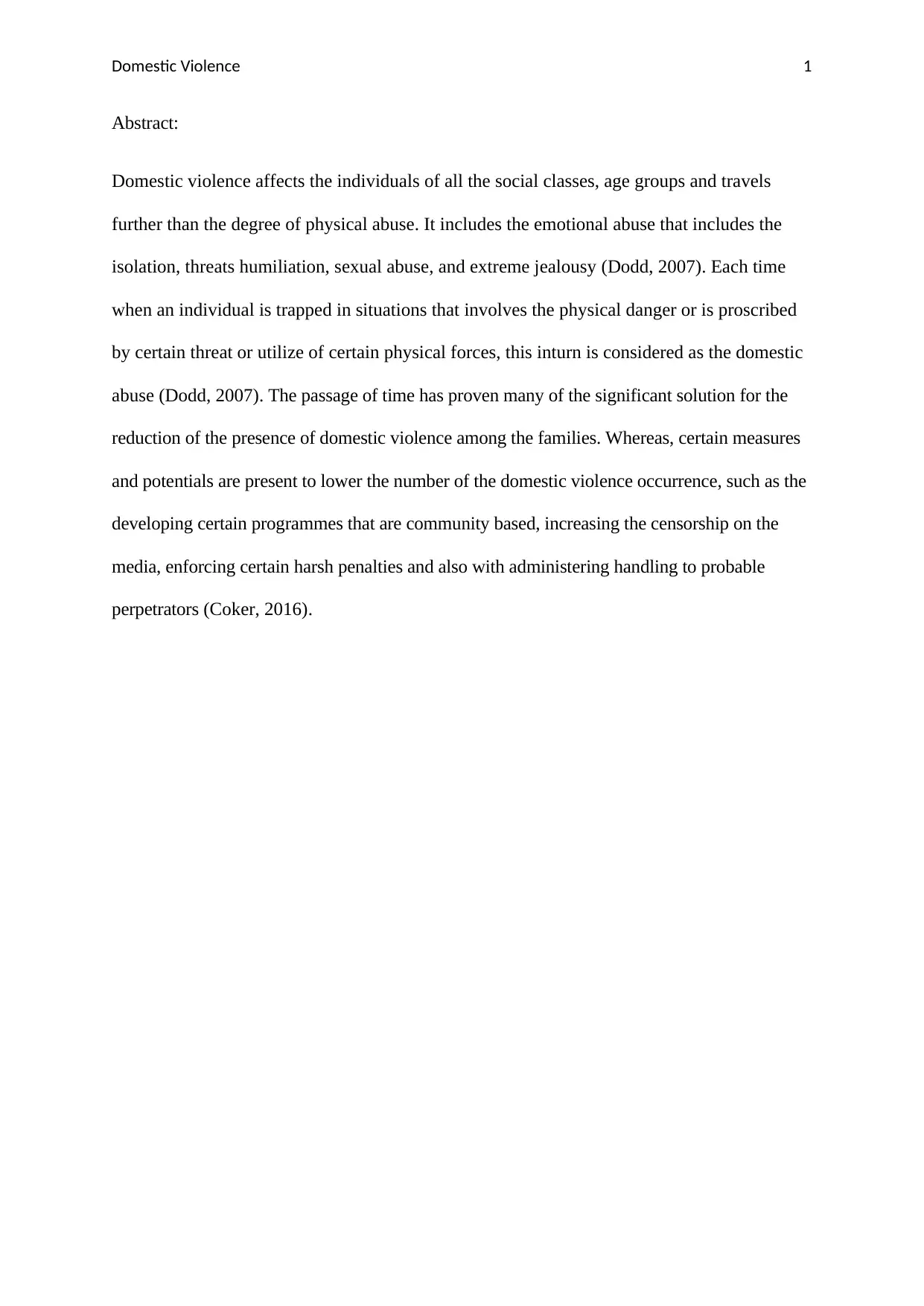
Domestic Violence 1
Abstract:
Domestic violence affects the individuals of all the social classes, age groups and travels
further than the degree of physical abuse. It includes the emotional abuse that includes the
isolation, threats humiliation, sexual abuse, and extreme jealousy (Dodd, 2007). Each time
when an individual is trapped in situations that involves the physical danger or is proscribed
by certain threat or utilize of certain physical forces, this inturn is considered as the domestic
abuse (Dodd, 2007). The passage of time has proven many of the significant solution for the
reduction of the presence of domestic violence among the families. Whereas, certain measures
and potentials are present to lower the number of the domestic violence occurrence, such as the
developing certain programmes that are community based, increasing the censorship on the
media, enforcing certain harsh penalties and also with administering handling to probable
perpetrators (Coker, 2016).
Abstract:
Domestic violence affects the individuals of all the social classes, age groups and travels
further than the degree of physical abuse. It includes the emotional abuse that includes the
isolation, threats humiliation, sexual abuse, and extreme jealousy (Dodd, 2007). Each time
when an individual is trapped in situations that involves the physical danger or is proscribed
by certain threat or utilize of certain physical forces, this inturn is considered as the domestic
abuse (Dodd, 2007). The passage of time has proven many of the significant solution for the
reduction of the presence of domestic violence among the families. Whereas, certain measures
and potentials are present to lower the number of the domestic violence occurrence, such as the
developing certain programmes that are community based, increasing the censorship on the
media, enforcing certain harsh penalties and also with administering handling to probable
perpetrators (Coker, 2016).
Secure Best Marks with AI Grader
Need help grading? Try our AI Grader for instant feedback on your assignments.
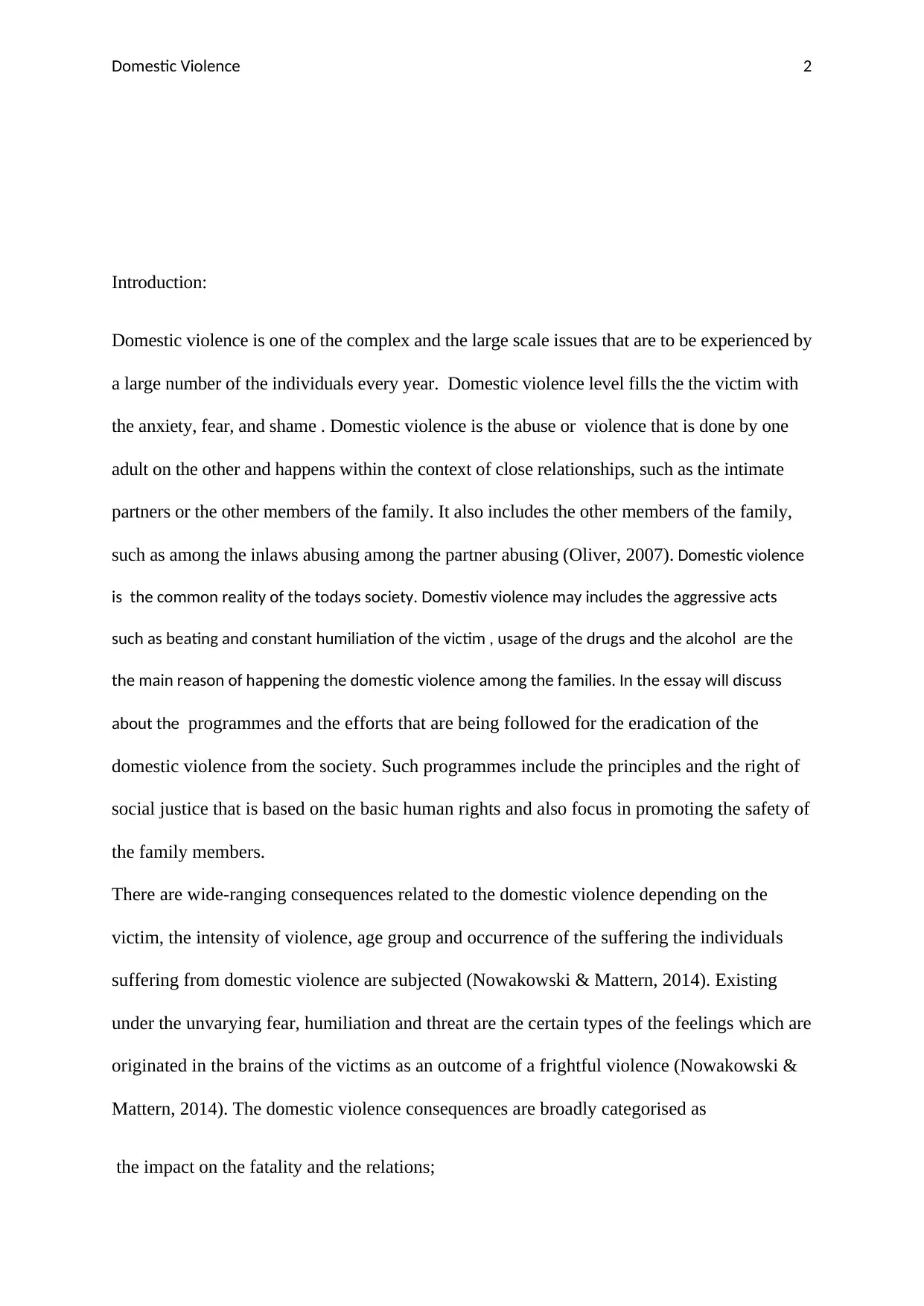
Domestic Violence 2
Introduction:
Domestic violence is one of the complex and the large scale issues that are to be experienced by
a large number of the individuals every year. Domestic violence level fills the the victim with
the anxiety, fear, and shame . Domestic violence is the abuse or violence that is done by one
adult on the other and happens within the context of close relationships, such as the intimate
partners or the other members of the family. It also includes the other members of the family,
such as among the inlaws abusing among the partner abusing (Oliver, 2007). Domestic violence
is the common reality of the todays society. Domestiv violence may includes the aggressive acts
such as beating and constant humiliation of the victim , usage of the drugs and the alcohol are the
the main reason of happening the domestic violence among the families. In the essay will discuss
about the programmes and the efforts that are being followed for the eradication of the
domestic violence from the society. Such programmes include the principles and the right of
social justice that is based on the basic human rights and also focus in promoting the safety of
the family members.
There are wide-ranging consequences related to the domestic violence depending on the
victim, the intensity of violence, age group and occurrence of the suffering the individuals
suffering from domestic violence are subjected (Nowakowski & Mattern, 2014). Existing
under the unvarying fear, humiliation and threat are the certain types of the feelings which are
originated in the brains of the victims as an outcome of a frightful violence (Nowakowski &
Mattern, 2014). The domestic violence consequences are broadly categorised as
the impact on the fatality and the relations;
Introduction:
Domestic violence is one of the complex and the large scale issues that are to be experienced by
a large number of the individuals every year. Domestic violence level fills the the victim with
the anxiety, fear, and shame . Domestic violence is the abuse or violence that is done by one
adult on the other and happens within the context of close relationships, such as the intimate
partners or the other members of the family. It also includes the other members of the family,
such as among the inlaws abusing among the partner abusing (Oliver, 2007). Domestic violence
is the common reality of the todays society. Domestiv violence may includes the aggressive acts
such as beating and constant humiliation of the victim , usage of the drugs and the alcohol are the
the main reason of happening the domestic violence among the families. In the essay will discuss
about the programmes and the efforts that are being followed for the eradication of the
domestic violence from the society. Such programmes include the principles and the right of
social justice that is based on the basic human rights and also focus in promoting the safety of
the family members.
There are wide-ranging consequences related to the domestic violence depending on the
victim, the intensity of violence, age group and occurrence of the suffering the individuals
suffering from domestic violence are subjected (Nowakowski & Mattern, 2014). Existing
under the unvarying fear, humiliation and threat are the certain types of the feelings which are
originated in the brains of the victims as an outcome of a frightful violence (Nowakowski &
Mattern, 2014). The domestic violence consequences are broadly categorised as
the impact on the fatality and the relations;
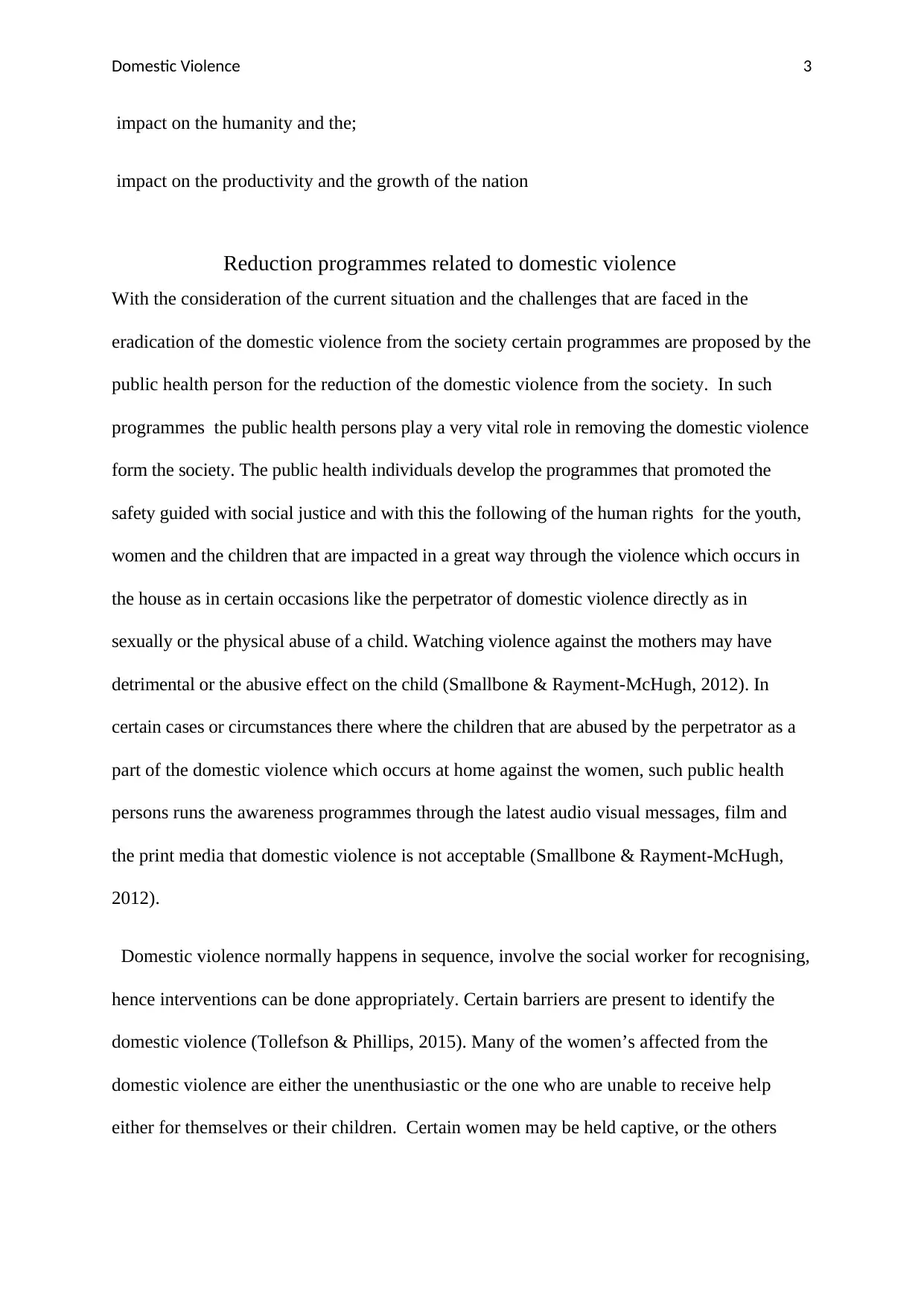
Domestic Violence 3
impact on the humanity and the;
impact on the productivity and the growth of the nation
Reduction programmes related to domestic violence
With the consideration of the current situation and the challenges that are faced in the
eradication of the domestic violence from the society certain programmes are proposed by the
public health person for the reduction of the domestic violence from the society. In such
programmes the public health persons play a very vital role in removing the domestic violence
form the society. The public health individuals develop the programmes that promoted the
safety guided with social justice and with this the following of the human rights for the youth,
women and the children that are impacted in a great way through the violence which occurs in
the house as in certain occasions like the perpetrator of domestic violence directly as in
sexually or the physical abuse of a child. Watching violence against the mothers may have
detrimental or the abusive effect on the child (Smallbone & Rayment-McHugh, 2012). In
certain cases or circumstances there where the children that are abused by the perpetrator as a
part of the domestic violence which occurs at home against the women, such public health
persons runs the awareness programmes through the latest audio visual messages, film and
the print media that domestic violence is not acceptable (Smallbone & Rayment-McHugh,
2012).
Domestic violence normally happens in sequence, involve the social worker for recognising,
hence interventions can be done appropriately. Certain barriers are present to identify the
domestic violence (Tollefson & Phillips, 2015). Many of the women’s affected from the
domestic violence are either the unenthusiastic or the one who are unable to receive help
either for themselves or their children. Certain women may be held captive, or the others
impact on the humanity and the;
impact on the productivity and the growth of the nation
Reduction programmes related to domestic violence
With the consideration of the current situation and the challenges that are faced in the
eradication of the domestic violence from the society certain programmes are proposed by the
public health person for the reduction of the domestic violence from the society. In such
programmes the public health persons play a very vital role in removing the domestic violence
form the society. The public health individuals develop the programmes that promoted the
safety guided with social justice and with this the following of the human rights for the youth,
women and the children that are impacted in a great way through the violence which occurs in
the house as in certain occasions like the perpetrator of domestic violence directly as in
sexually or the physical abuse of a child. Watching violence against the mothers may have
detrimental or the abusive effect on the child (Smallbone & Rayment-McHugh, 2012). In
certain cases or circumstances there where the children that are abused by the perpetrator as a
part of the domestic violence which occurs at home against the women, such public health
persons runs the awareness programmes through the latest audio visual messages, film and
the print media that domestic violence is not acceptable (Smallbone & Rayment-McHugh,
2012).
Domestic violence normally happens in sequence, involve the social worker for recognising,
hence interventions can be done appropriately. Certain barriers are present to identify the
domestic violence (Tollefson & Phillips, 2015). Many of the women’s affected from the
domestic violence are either the unenthusiastic or the one who are unable to receive help
either for themselves or their children. Certain women may be held captive, or the others
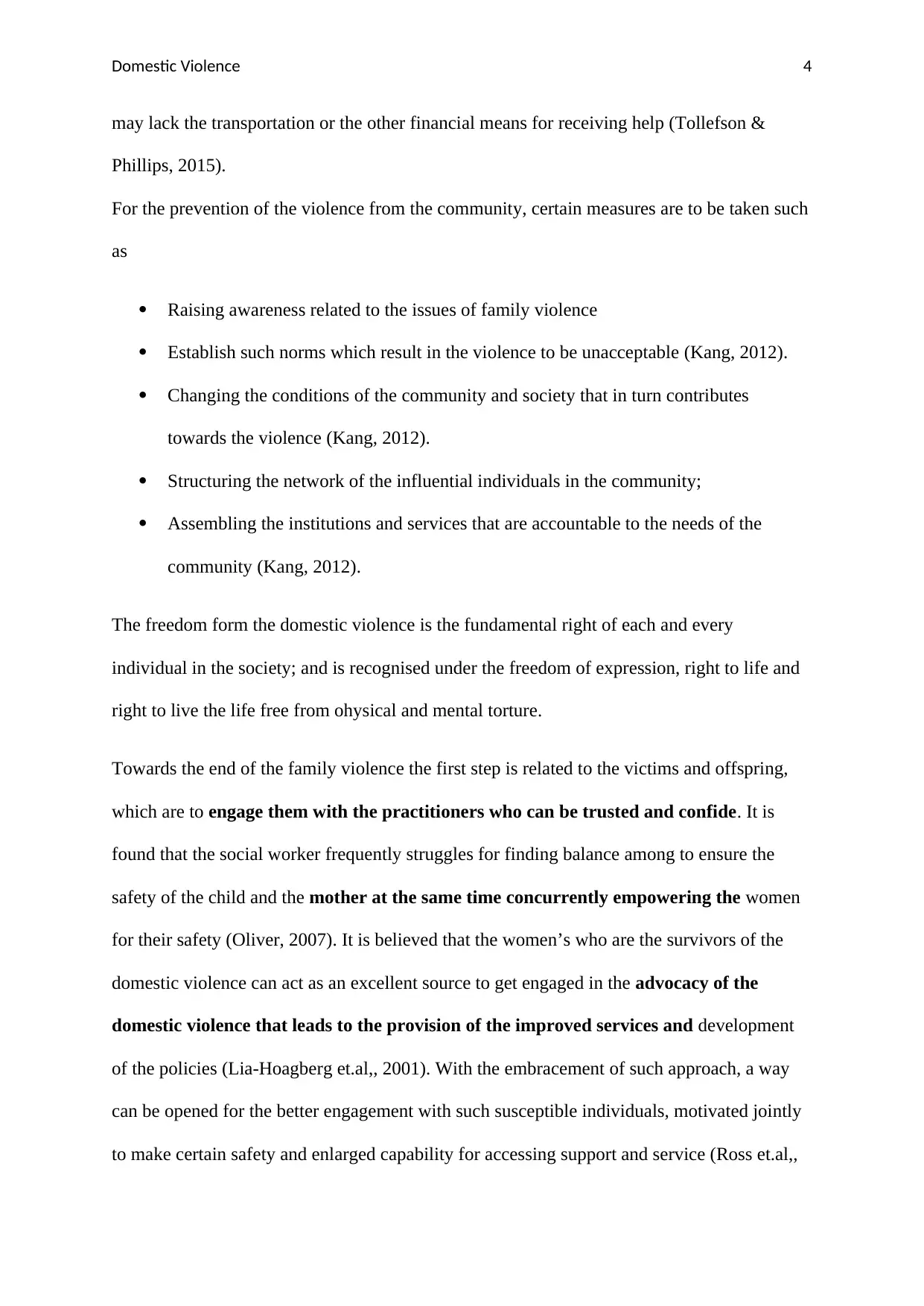
Domestic Violence 4
may lack the transportation or the other financial means for receiving help (Tollefson &
Phillips, 2015).
For the prevention of the violence from the community, certain measures are to be taken such
as
Raising awareness related to the issues of family violence
Establish such norms which result in the violence to be unacceptable (Kang, 2012).
Changing the conditions of the community and society that in turn contributes
towards the violence (Kang, 2012).
Structuring the network of the influential individuals in the community;
Assembling the institutions and services that are accountable to the needs of the
community (Kang, 2012).
The freedom form the domestic violence is the fundamental right of each and every
individual in the society; and is recognised under the freedom of expression, right to life and
right to live the life free from ohysical and mental torture.
Towards the end of the family violence the first step is related to the victims and offspring,
which are to engage them with the practitioners who can be trusted and confide. It is
found that the social worker frequently struggles for finding balance among to ensure the
safety of the child and the mother at the same time concurrently empowering the women
for their safety (Oliver, 2007). It is believed that the women’s who are the survivors of the
domestic violence can act as an excellent source to get engaged in the advocacy of the
domestic violence that leads to the provision of the improved services and development
of the policies (Lia-Hoagberg et.al,, 2001). With the embracement of such approach, a way
can be opened for the better engagement with such susceptible individuals, motivated jointly
to make certain safety and enlarged capability for accessing support and service (Ross et.al,,
may lack the transportation or the other financial means for receiving help (Tollefson &
Phillips, 2015).
For the prevention of the violence from the community, certain measures are to be taken such
as
Raising awareness related to the issues of family violence
Establish such norms which result in the violence to be unacceptable (Kang, 2012).
Changing the conditions of the community and society that in turn contributes
towards the violence (Kang, 2012).
Structuring the network of the influential individuals in the community;
Assembling the institutions and services that are accountable to the needs of the
community (Kang, 2012).
The freedom form the domestic violence is the fundamental right of each and every
individual in the society; and is recognised under the freedom of expression, right to life and
right to live the life free from ohysical and mental torture.
Towards the end of the family violence the first step is related to the victims and offspring,
which are to engage them with the practitioners who can be trusted and confide. It is
found that the social worker frequently struggles for finding balance among to ensure the
safety of the child and the mother at the same time concurrently empowering the women
for their safety (Oliver, 2007). It is believed that the women’s who are the survivors of the
domestic violence can act as an excellent source to get engaged in the advocacy of the
domestic violence that leads to the provision of the improved services and development
of the policies (Lia-Hoagberg et.al,, 2001). With the embracement of such approach, a way
can be opened for the better engagement with such susceptible individuals, motivated jointly
to make certain safety and enlarged capability for accessing support and service (Ross et.al,,
Secure Best Marks with AI Grader
Need help grading? Try our AI Grader for instant feedback on your assignments.
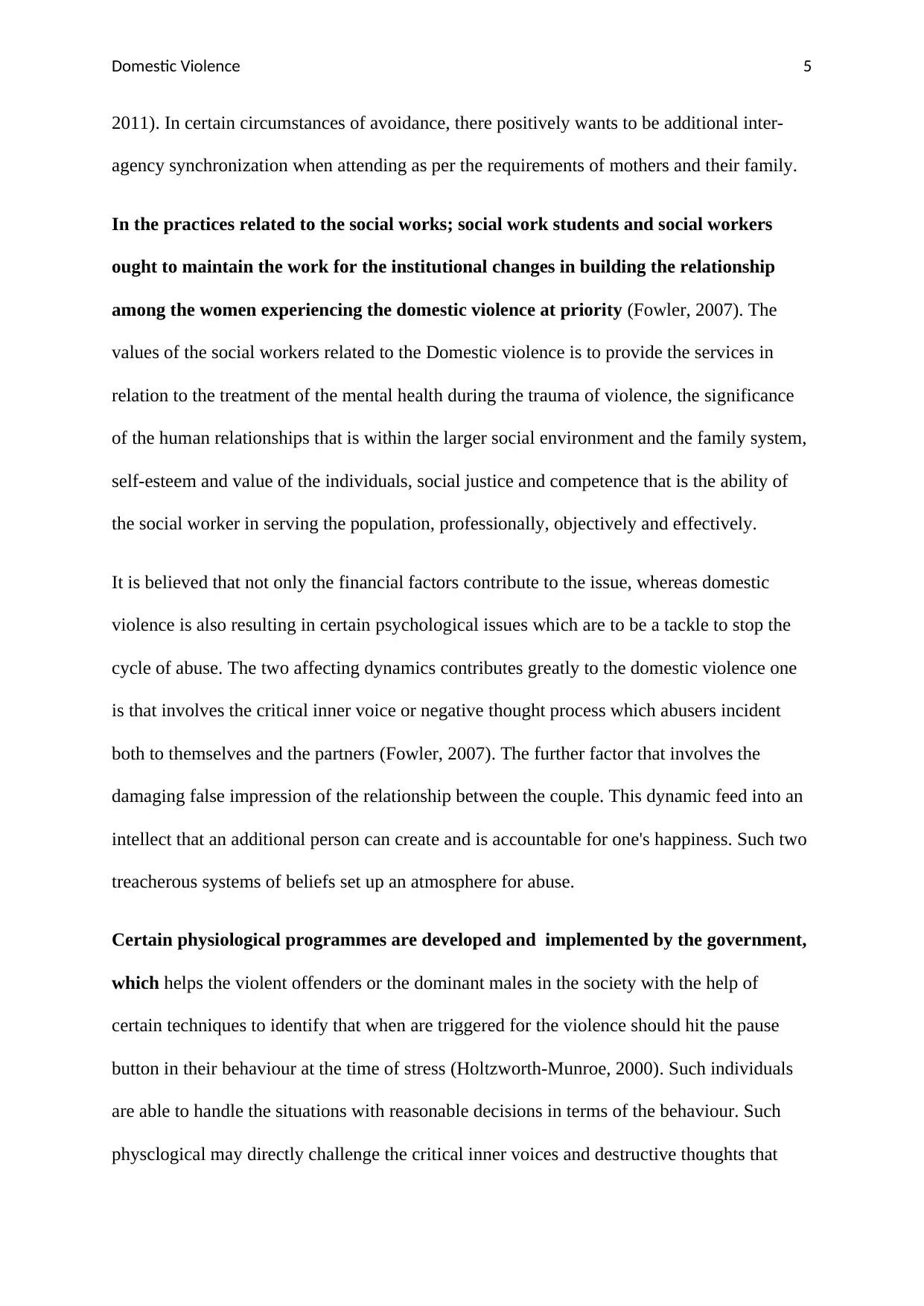
Domestic Violence 5
2011). In certain circumstances of avoidance, there positively wants to be additional inter-
agency synchronization when attending as per the requirements of mothers and their family.
In the practices related to the social works; social work students and social workers
ought to maintain the work for the institutional changes in building the relationship
among the women experiencing the domestic violence at priority (Fowler, 2007). The
values of the social workers related to the Domestic violence is to provide the services in
relation to the treatment of the mental health during the trauma of violence, the significance
of the human relationships that is within the larger social environment and the family system,
self-esteem and value of the individuals, social justice and competence that is the ability of
the social worker in serving the population, professionally, objectively and effectively.
It is believed that not only the financial factors contribute to the issue, whereas domestic
violence is also resulting in certain psychological issues which are to be a tackle to stop the
cycle of abuse. The two affecting dynamics contributes greatly to the domestic violence one
is that involves the critical inner voice or negative thought process which abusers incident
both to themselves and the partners (Fowler, 2007). The further factor that involves the
damaging false impression of the relationship between the couple. This dynamic feed into an
intellect that an additional person can create and is accountable for one's happiness. Such two
treacherous systems of beliefs set up an atmosphere for abuse.
Certain physiological programmes are developed and implemented by the government,
which helps the violent offenders or the dominant males in the society with the help of
certain techniques to identify that when are triggered for the violence should hit the pause
button in their behaviour at the time of stress (Holtzworth-Munroe, 2000). Such individuals
are able to handle the situations with reasonable decisions in terms of the behaviour. Such
physclogical may directly challenge the critical inner voices and destructive thoughts that
2011). In certain circumstances of avoidance, there positively wants to be additional inter-
agency synchronization when attending as per the requirements of mothers and their family.
In the practices related to the social works; social work students and social workers
ought to maintain the work for the institutional changes in building the relationship
among the women experiencing the domestic violence at priority (Fowler, 2007). The
values of the social workers related to the Domestic violence is to provide the services in
relation to the treatment of the mental health during the trauma of violence, the significance
of the human relationships that is within the larger social environment and the family system,
self-esteem and value of the individuals, social justice and competence that is the ability of
the social worker in serving the population, professionally, objectively and effectively.
It is believed that not only the financial factors contribute to the issue, whereas domestic
violence is also resulting in certain psychological issues which are to be a tackle to stop the
cycle of abuse. The two affecting dynamics contributes greatly to the domestic violence one
is that involves the critical inner voice or negative thought process which abusers incident
both to themselves and the partners (Fowler, 2007). The further factor that involves the
damaging false impression of the relationship between the couple. This dynamic feed into an
intellect that an additional person can create and is accountable for one's happiness. Such two
treacherous systems of beliefs set up an atmosphere for abuse.
Certain physiological programmes are developed and implemented by the government,
which helps the violent offenders or the dominant males in the society with the help of
certain techniques to identify that when are triggered for the violence should hit the pause
button in their behaviour at the time of stress (Holtzworth-Munroe, 2000). Such individuals
are able to handle the situations with reasonable decisions in terms of the behaviour. Such
physclogical may directly challenge the critical inner voices and destructive thoughts that
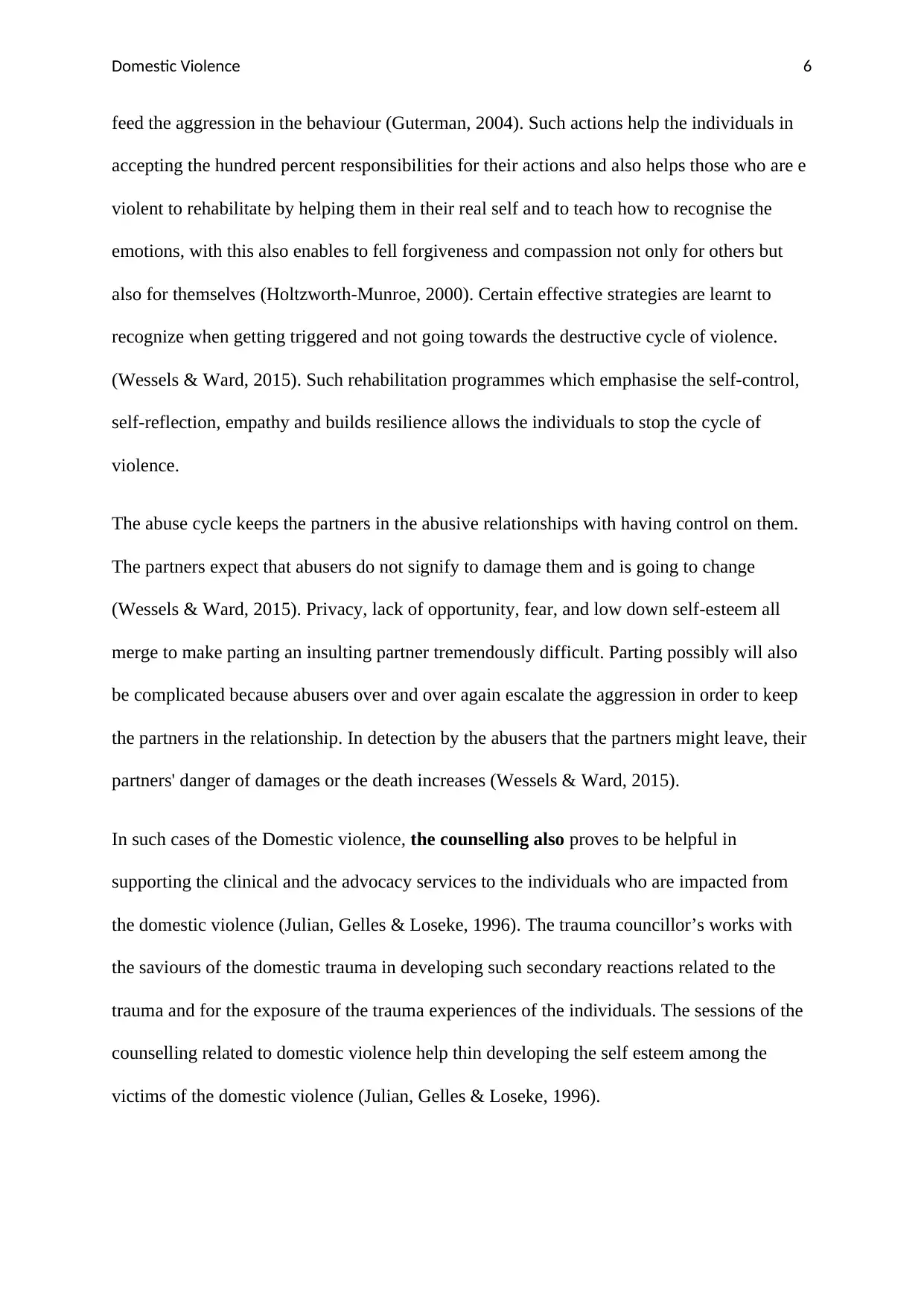
Domestic Violence 6
feed the aggression in the behaviour (Guterman, 2004). Such actions help the individuals in
accepting the hundred percent responsibilities for their actions and also helps those who are e
violent to rehabilitate by helping them in their real self and to teach how to recognise the
emotions, with this also enables to fell forgiveness and compassion not only for others but
also for themselves (Holtzworth-Munroe, 2000). Certain effective strategies are learnt to
recognize when getting triggered and not going towards the destructive cycle of violence.
(Wessels & Ward, 2015). Such rehabilitation programmes which emphasise the self-control,
self-reflection, empathy and builds resilience allows the individuals to stop the cycle of
violence.
The abuse cycle keeps the partners in the abusive relationships with having control on them.
The partners expect that abusers do not signify to damage them and is going to change
(Wessels & Ward, 2015). Privacy, lack of opportunity, fear, and low down self-esteem all
merge to make parting an insulting partner tremendously difficult. Parting possibly will also
be complicated because abusers over and over again escalate the aggression in order to keep
the partners in the relationship. In detection by the abusers that the partners might leave, their
partners' danger of damages or the death increases (Wessels & Ward, 2015).
In such cases of the Domestic violence, the counselling also proves to be helpful in
supporting the clinical and the advocacy services to the individuals who are impacted from
the domestic violence (Julian, Gelles & Loseke, 1996). The trauma councillor’s works with
the saviours of the domestic trauma in developing such secondary reactions related to the
trauma and for the exposure of the trauma experiences of the individuals. The sessions of the
counselling related to domestic violence help thin developing the self esteem among the
victims of the domestic violence (Julian, Gelles & Loseke, 1996).
feed the aggression in the behaviour (Guterman, 2004). Such actions help the individuals in
accepting the hundred percent responsibilities for their actions and also helps those who are e
violent to rehabilitate by helping them in their real self and to teach how to recognise the
emotions, with this also enables to fell forgiveness and compassion not only for others but
also for themselves (Holtzworth-Munroe, 2000). Certain effective strategies are learnt to
recognize when getting triggered and not going towards the destructive cycle of violence.
(Wessels & Ward, 2015). Such rehabilitation programmes which emphasise the self-control,
self-reflection, empathy and builds resilience allows the individuals to stop the cycle of
violence.
The abuse cycle keeps the partners in the abusive relationships with having control on them.
The partners expect that abusers do not signify to damage them and is going to change
(Wessels & Ward, 2015). Privacy, lack of opportunity, fear, and low down self-esteem all
merge to make parting an insulting partner tremendously difficult. Parting possibly will also
be complicated because abusers over and over again escalate the aggression in order to keep
the partners in the relationship. In detection by the abusers that the partners might leave, their
partners' danger of damages or the death increases (Wessels & Ward, 2015).
In such cases of the Domestic violence, the counselling also proves to be helpful in
supporting the clinical and the advocacy services to the individuals who are impacted from
the domestic violence (Julian, Gelles & Loseke, 1996). The trauma councillor’s works with
the saviours of the domestic trauma in developing such secondary reactions related to the
trauma and for the exposure of the trauma experiences of the individuals. The sessions of the
counselling related to domestic violence help thin developing the self esteem among the
victims of the domestic violence (Julian, Gelles & Loseke, 1996).
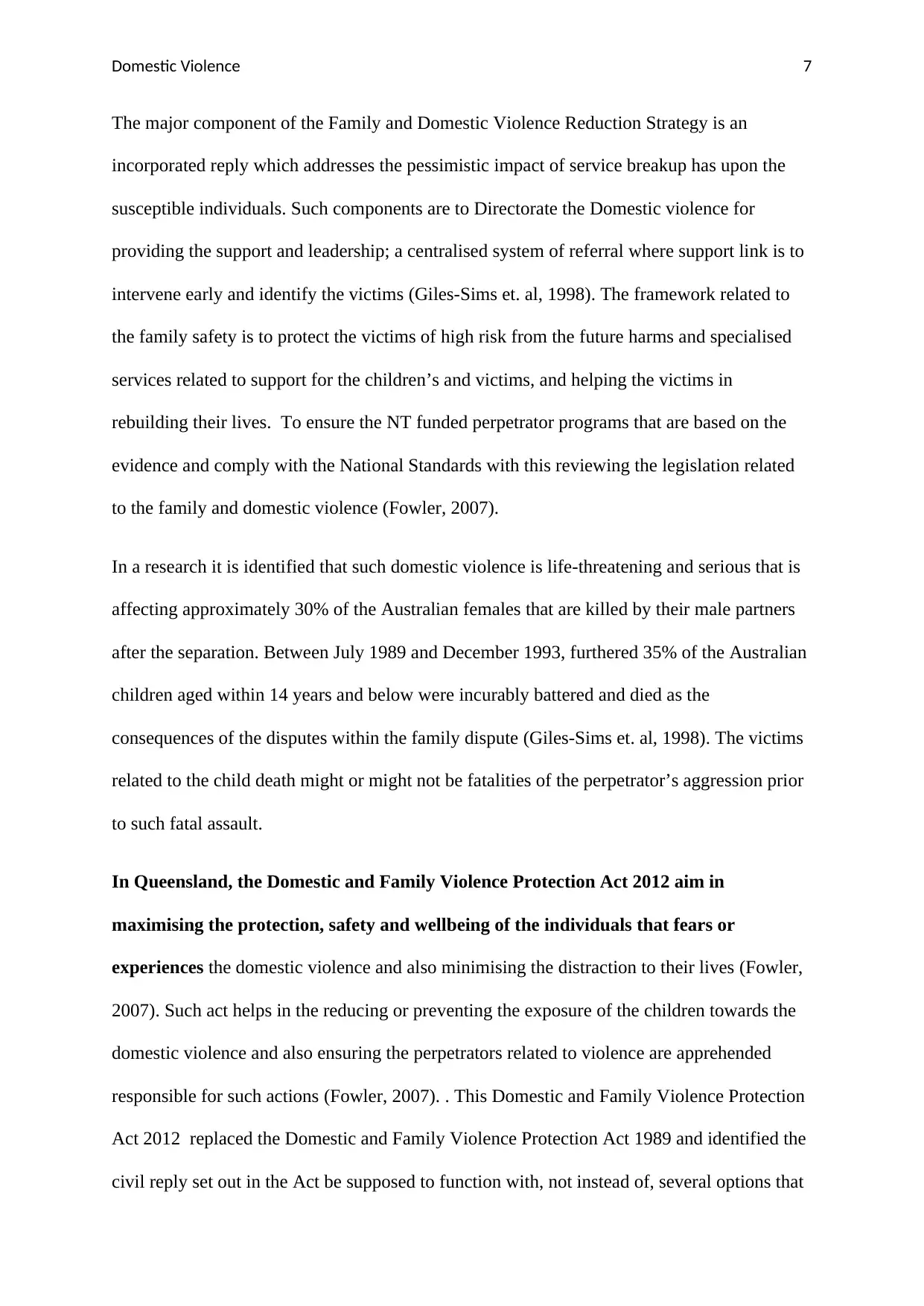
Domestic Violence 7
The major component of the Family and Domestic Violence Reduction Strategy is an
incorporated reply which addresses the pessimistic impact of service breakup has upon the
susceptible individuals. Such components are to Directorate the Domestic violence for
providing the support and leadership; a centralised system of referral where support link is to
intervene early and identify the victims (Giles-Sims et. al, 1998). The framework related to
the family safety is to protect the victims of high risk from the future harms and specialised
services related to support for the children’s and victims, and helping the victims in
rebuilding their lives. To ensure the NT funded perpetrator programs that are based on the
evidence and comply with the National Standards with this reviewing the legislation related
to the family and domestic violence (Fowler, 2007).
In a research it is identified that such domestic violence is life-threatening and serious that is
affecting approximately 30% of the Australian females that are killed by their male partners
after the separation. Between July 1989 and December 1993, furthered 35% of the Australian
children aged within 14 years and below were incurably battered and died as the
consequences of the disputes within the family dispute (Giles-Sims et. al, 1998). The victims
related to the child death might or might not be fatalities of the perpetrator’s aggression prior
to such fatal assault.
In Queensland, the Domestic and Family Violence Protection Act 2012 aim in
maximising the protection, safety and wellbeing of the individuals that fears or
experiences the domestic violence and also minimising the distraction to their lives (Fowler,
2007). Such act helps in the reducing or preventing the exposure of the children towards the
domestic violence and also ensuring the perpetrators related to violence are apprehended
responsible for such actions (Fowler, 2007). . This Domestic and Family Violence Protection
Act 2012 replaced the Domestic and Family Violence Protection Act 1989 and identified the
civil reply set out in the Act be supposed to function with, not instead of, several options that
The major component of the Family and Domestic Violence Reduction Strategy is an
incorporated reply which addresses the pessimistic impact of service breakup has upon the
susceptible individuals. Such components are to Directorate the Domestic violence for
providing the support and leadership; a centralised system of referral where support link is to
intervene early and identify the victims (Giles-Sims et. al, 1998). The framework related to
the family safety is to protect the victims of high risk from the future harms and specialised
services related to support for the children’s and victims, and helping the victims in
rebuilding their lives. To ensure the NT funded perpetrator programs that are based on the
evidence and comply with the National Standards with this reviewing the legislation related
to the family and domestic violence (Fowler, 2007).
In a research it is identified that such domestic violence is life-threatening and serious that is
affecting approximately 30% of the Australian females that are killed by their male partners
after the separation. Between July 1989 and December 1993, furthered 35% of the Australian
children aged within 14 years and below were incurably battered and died as the
consequences of the disputes within the family dispute (Giles-Sims et. al, 1998). The victims
related to the child death might or might not be fatalities of the perpetrator’s aggression prior
to such fatal assault.
In Queensland, the Domestic and Family Violence Protection Act 2012 aim in
maximising the protection, safety and wellbeing of the individuals that fears or
experiences the domestic violence and also minimising the distraction to their lives (Fowler,
2007). Such act helps in the reducing or preventing the exposure of the children towards the
domestic violence and also ensuring the perpetrators related to violence are apprehended
responsible for such actions (Fowler, 2007). . This Domestic and Family Violence Protection
Act 2012 replaced the Domestic and Family Violence Protection Act 1989 and identified the
civil reply set out in the Act be supposed to function with, not instead of, several options that
Paraphrase This Document
Need a fresh take? Get an instant paraphrase of this document with our AI Paraphraser
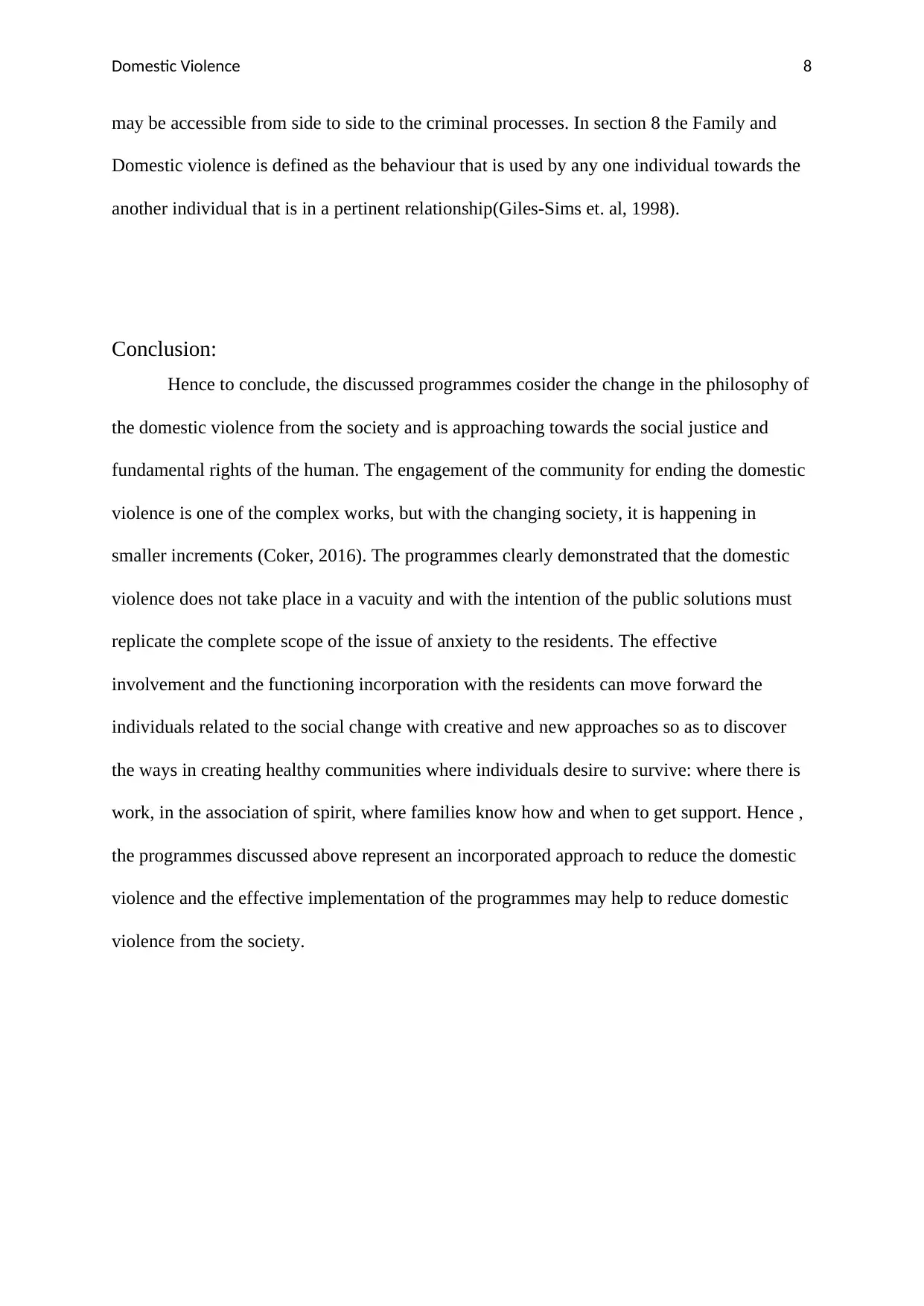
Domestic Violence 8
may be accessible from side to side to the criminal processes. In section 8 the Family and
Domestic violence is defined as the behaviour that is used by any one individual towards the
another individual that is in a pertinent relationship(Giles-Sims et. al, 1998).
Conclusion:
Hence to conclude, the discussed programmes cosider the change in the philosophy of
the domestic violence from the society and is approaching towards the social justice and
fundamental rights of the human. The engagement of the community for ending the domestic
violence is one of the complex works, but with the changing society, it is happening in
smaller increments (Coker, 2016). The programmes clearly demonstrated that the domestic
violence does not take place in a vacuity and with the intention of the public solutions must
replicate the complete scope of the issue of anxiety to the residents. The effective
involvement and the functioning incorporation with the residents can move forward the
individuals related to the social change with creative and new approaches so as to discover
the ways in creating healthy communities where individuals desire to survive: where there is
work, in the association of spirit, where families know how and when to get support. Hence ,
the programmes discussed above represent an incorporated approach to reduce the domestic
violence and the effective implementation of the programmes may help to reduce domestic
violence from the society.
may be accessible from side to side to the criminal processes. In section 8 the Family and
Domestic violence is defined as the behaviour that is used by any one individual towards the
another individual that is in a pertinent relationship(Giles-Sims et. al, 1998).
Conclusion:
Hence to conclude, the discussed programmes cosider the change in the philosophy of
the domestic violence from the society and is approaching towards the social justice and
fundamental rights of the human. The engagement of the community for ending the domestic
violence is one of the complex works, but with the changing society, it is happening in
smaller increments (Coker, 2016). The programmes clearly demonstrated that the domestic
violence does not take place in a vacuity and with the intention of the public solutions must
replicate the complete scope of the issue of anxiety to the residents. The effective
involvement and the functioning incorporation with the residents can move forward the
individuals related to the social change with creative and new approaches so as to discover
the ways in creating healthy communities where individuals desire to survive: where there is
work, in the association of spirit, where families know how and when to get support. Hence ,
the programmes discussed above represent an incorporated approach to reduce the domestic
violence and the effective implementation of the programmes may help to reduce domestic
violence from the society.
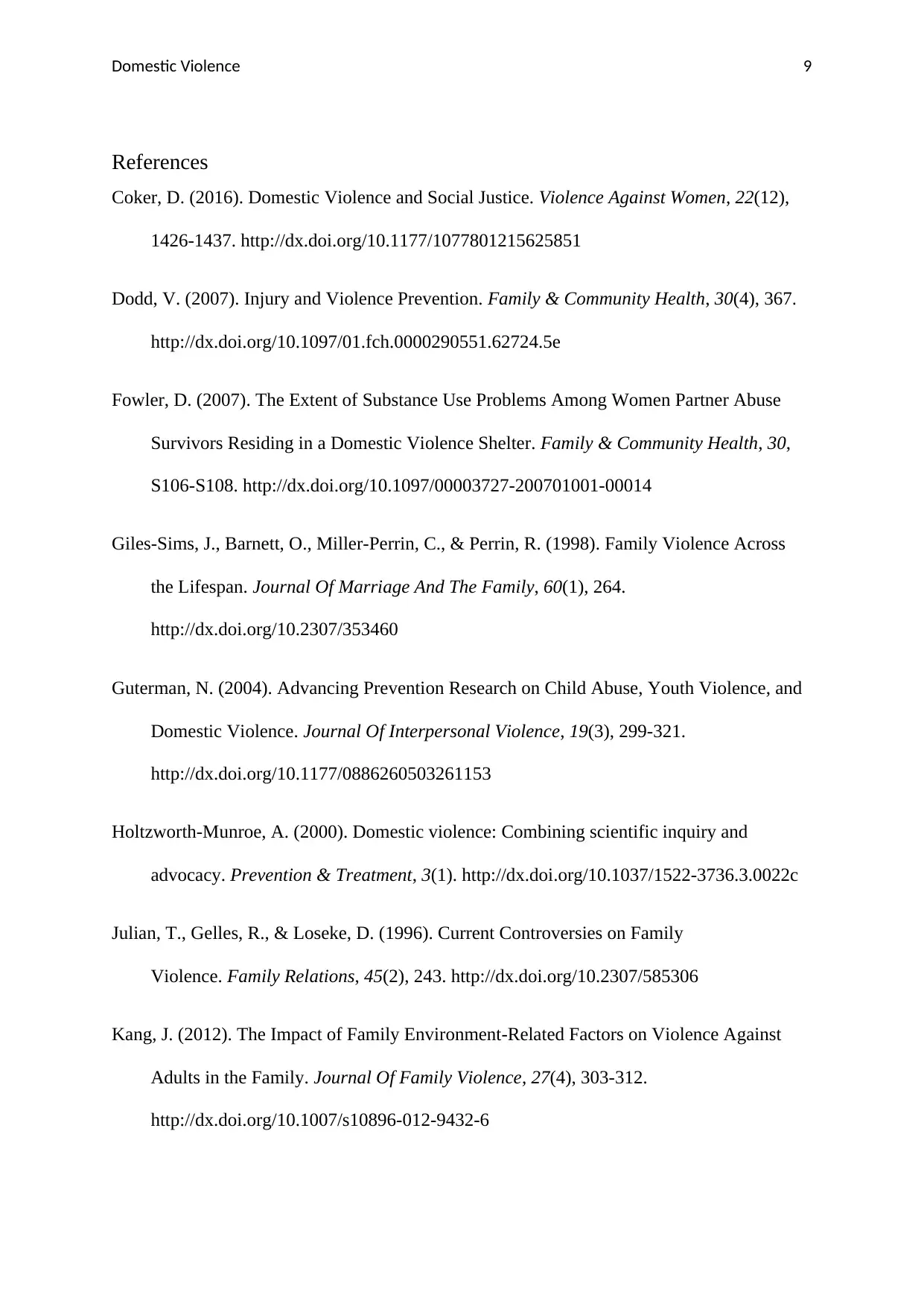
Domestic Violence 9
References
Coker, D. (2016). Domestic Violence and Social Justice. Violence Against Women, 22(12),
1426-1437. http://dx.doi.org/10.1177/1077801215625851
Dodd, V. (2007). Injury and Violence Prevention. Family & Community Health, 30(4), 367.
http://dx.doi.org/10.1097/01.fch.0000290551.62724.5e
Fowler, D. (2007). The Extent of Substance Use Problems Among Women Partner Abuse
Survivors Residing in a Domestic Violence Shelter. Family & Community Health, 30,
S106-S108. http://dx.doi.org/10.1097/00003727-200701001-00014
Giles-Sims, J., Barnett, O., Miller-Perrin, C., & Perrin, R. (1998). Family Violence Across
the Lifespan. Journal Of Marriage And The Family, 60(1), 264.
http://dx.doi.org/10.2307/353460
Guterman, N. (2004). Advancing Prevention Research on Child Abuse, Youth Violence, and
Domestic Violence. Journal Of Interpersonal Violence, 19(3), 299-321.
http://dx.doi.org/10.1177/0886260503261153
Holtzworth-Munroe, A. (2000). Domestic violence: Combining scientific inquiry and
advocacy. Prevention & Treatment, 3(1). http://dx.doi.org/10.1037/1522-3736.3.0022c
Julian, T., Gelles, R., & Loseke, D. (1996). Current Controversies on Family
Violence. Family Relations, 45(2), 243. http://dx.doi.org/10.2307/585306
Kang, J. (2012). The Impact of Family Environment-Related Factors on Violence Against
Adults in the Family. Journal Of Family Violence, 27(4), 303-312.
http://dx.doi.org/10.1007/s10896-012-9432-6
References
Coker, D. (2016). Domestic Violence and Social Justice. Violence Against Women, 22(12),
1426-1437. http://dx.doi.org/10.1177/1077801215625851
Dodd, V. (2007). Injury and Violence Prevention. Family & Community Health, 30(4), 367.
http://dx.doi.org/10.1097/01.fch.0000290551.62724.5e
Fowler, D. (2007). The Extent of Substance Use Problems Among Women Partner Abuse
Survivors Residing in a Domestic Violence Shelter. Family & Community Health, 30,
S106-S108. http://dx.doi.org/10.1097/00003727-200701001-00014
Giles-Sims, J., Barnett, O., Miller-Perrin, C., & Perrin, R. (1998). Family Violence Across
the Lifespan. Journal Of Marriage And The Family, 60(1), 264.
http://dx.doi.org/10.2307/353460
Guterman, N. (2004). Advancing Prevention Research on Child Abuse, Youth Violence, and
Domestic Violence. Journal Of Interpersonal Violence, 19(3), 299-321.
http://dx.doi.org/10.1177/0886260503261153
Holtzworth-Munroe, A. (2000). Domestic violence: Combining scientific inquiry and
advocacy. Prevention & Treatment, 3(1). http://dx.doi.org/10.1037/1522-3736.3.0022c
Julian, T., Gelles, R., & Loseke, D. (1996). Current Controversies on Family
Violence. Family Relations, 45(2), 243. http://dx.doi.org/10.2307/585306
Kang, J. (2012). The Impact of Family Environment-Related Factors on Violence Against
Adults in the Family. Journal Of Family Violence, 27(4), 303-312.
http://dx.doi.org/10.1007/s10896-012-9432-6
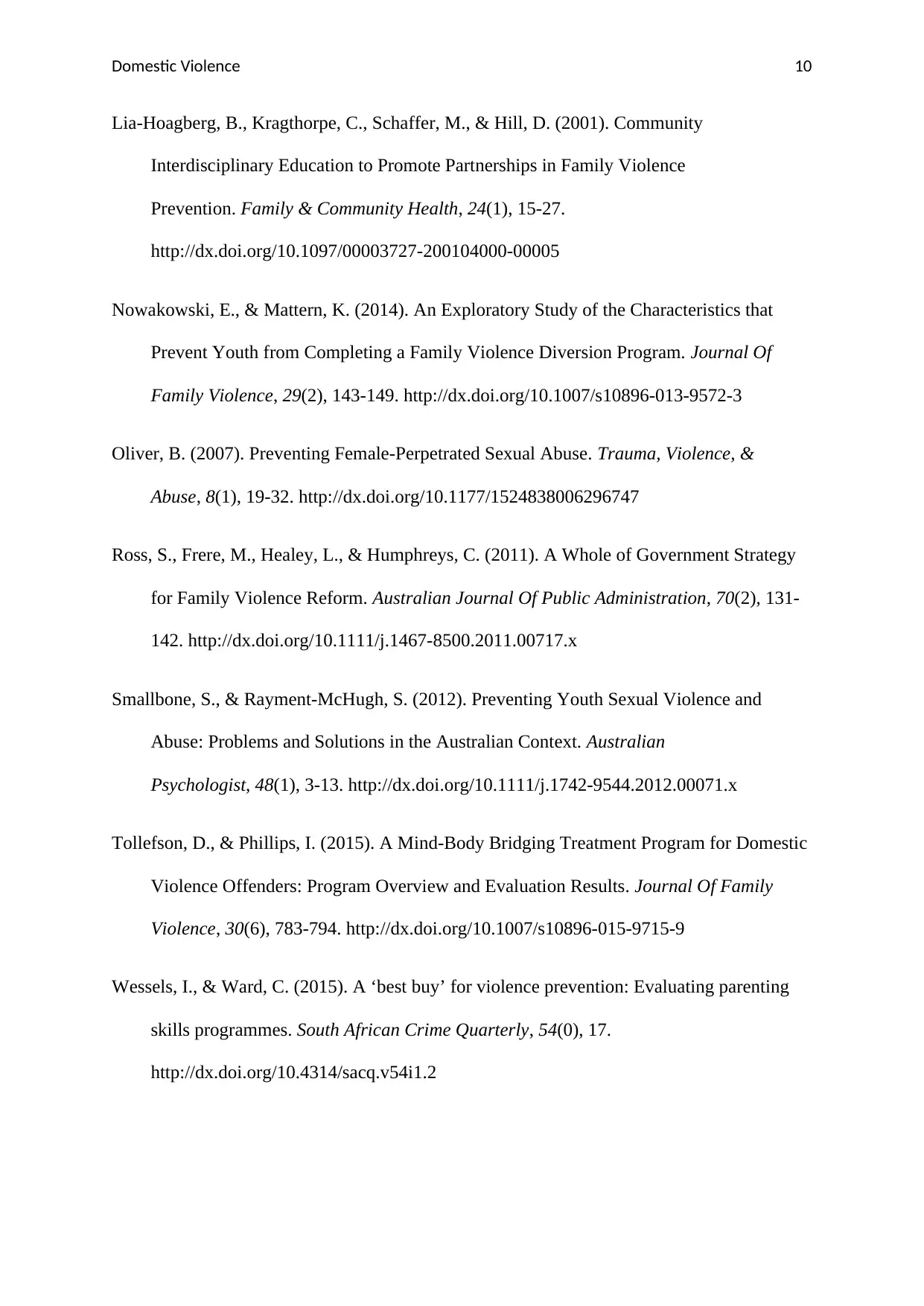
Domestic Violence 10
Lia-Hoagberg, B., Kragthorpe, C., Schaffer, M., & Hill, D. (2001). Community
Interdisciplinary Education to Promote Partnerships in Family Violence
Prevention. Family & Community Health, 24(1), 15-27.
http://dx.doi.org/10.1097/00003727-200104000-00005
Nowakowski, E., & Mattern, K. (2014). An Exploratory Study of the Characteristics that
Prevent Youth from Completing a Family Violence Diversion Program. Journal Of
Family Violence, 29(2), 143-149. http://dx.doi.org/10.1007/s10896-013-9572-3
Oliver, B. (2007). Preventing Female-Perpetrated Sexual Abuse. Trauma, Violence, &
Abuse, 8(1), 19-32. http://dx.doi.org/10.1177/1524838006296747
Ross, S., Frere, M., Healey, L., & Humphreys, C. (2011). A Whole of Government Strategy
for Family Violence Reform. Australian Journal Of Public Administration, 70(2), 131-
142. http://dx.doi.org/10.1111/j.1467-8500.2011.00717.x
Smallbone, S., & Rayment-McHugh, S. (2012). Preventing Youth Sexual Violence and
Abuse: Problems and Solutions in the Australian Context. Australian
Psychologist, 48(1), 3-13. http://dx.doi.org/10.1111/j.1742-9544.2012.00071.x
Tollefson, D., & Phillips, I. (2015). A Mind-Body Bridging Treatment Program for Domestic
Violence Offenders: Program Overview and Evaluation Results. Journal Of Family
Violence, 30(6), 783-794. http://dx.doi.org/10.1007/s10896-015-9715-9
Wessels, I., & Ward, C. (2015). A ‘best buy’ for violence prevention: Evaluating parenting
skills programmes. South African Crime Quarterly, 54(0), 17.
http://dx.doi.org/10.4314/sacq.v54i1.2
Lia-Hoagberg, B., Kragthorpe, C., Schaffer, M., & Hill, D. (2001). Community
Interdisciplinary Education to Promote Partnerships in Family Violence
Prevention. Family & Community Health, 24(1), 15-27.
http://dx.doi.org/10.1097/00003727-200104000-00005
Nowakowski, E., & Mattern, K. (2014). An Exploratory Study of the Characteristics that
Prevent Youth from Completing a Family Violence Diversion Program. Journal Of
Family Violence, 29(2), 143-149. http://dx.doi.org/10.1007/s10896-013-9572-3
Oliver, B. (2007). Preventing Female-Perpetrated Sexual Abuse. Trauma, Violence, &
Abuse, 8(1), 19-32. http://dx.doi.org/10.1177/1524838006296747
Ross, S., Frere, M., Healey, L., & Humphreys, C. (2011). A Whole of Government Strategy
for Family Violence Reform. Australian Journal Of Public Administration, 70(2), 131-
142. http://dx.doi.org/10.1111/j.1467-8500.2011.00717.x
Smallbone, S., & Rayment-McHugh, S. (2012). Preventing Youth Sexual Violence and
Abuse: Problems and Solutions in the Australian Context. Australian
Psychologist, 48(1), 3-13. http://dx.doi.org/10.1111/j.1742-9544.2012.00071.x
Tollefson, D., & Phillips, I. (2015). A Mind-Body Bridging Treatment Program for Domestic
Violence Offenders: Program Overview and Evaluation Results. Journal Of Family
Violence, 30(6), 783-794. http://dx.doi.org/10.1007/s10896-015-9715-9
Wessels, I., & Ward, C. (2015). A ‘best buy’ for violence prevention: Evaluating parenting
skills programmes. South African Crime Quarterly, 54(0), 17.
http://dx.doi.org/10.4314/sacq.v54i1.2
Secure Best Marks with AI Grader
Need help grading? Try our AI Grader for instant feedback on your assignments.

Domestic Violence 11
1 out of 11
Related Documents
Your All-in-One AI-Powered Toolkit for Academic Success.
+13062052269
info@desklib.com
Available 24*7 on WhatsApp / Email
![[object Object]](/_next/static/media/star-bottom.7253800d.svg)
Unlock your academic potential
© 2024 | Zucol Services PVT LTD | All rights reserved.




